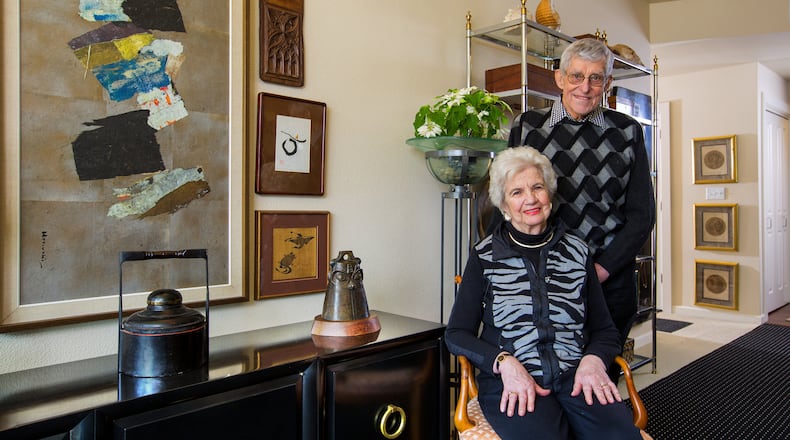SEATTLE — Jim Halverson called from across the street. He and his wife, Darlene, live in Mirabella Seattle, a multistory retirement community tantalizingly close to the newspaper. Jim, a retired interior designer, humbly offered a tour of their “collection of stuff” — and then he offered coffee and/or a martini.
You would’ve gone, too.
And you would’ve been awed, also (no beverages were consumed; for one thing, you would not want to spill here).
Jim and Darlene have circled the world almost as many times as the moon has: 50 trips to Hawaii, 15 or 20 to Europe, countless other places countless other times. As a result, their highly personalized two-bedroom, 1,350-square-foot apartment, where jazz plays every day, is filled with uniquely meaningful pieces that reflect their travels, their lives — and an incredible eye for design.
“We’ve been married 60 years, and we have 60 years’ of collections, odds and ends,” Jim says. “It’s a bit overloaded, actually, but it all has meaning.”
And it all — all — has a story:
— In the office/den, highlighted by a French Napoleonic campaign daybed, there’s a painting from Greenwich Village, a carving from New Guinea, apothecary jars from Madrid and a teapot from Edinburgh. “Jim was in the Navy and stopped in Scotland and bought that for a pack of cigarettes,” Darlene says.
— In the substantial dining-room cabinet, backed with a patterned fabric Jim printed, a collection of Wedgwood pitchers from 1750-1850 plays off the antique French wrought-iron chandelier and pizazz-adding black rug. “The first creamer and sugar bowl from Amsterdam started the collection,” Darlene says.
— In the living area: their “very first painting from Paris,” a piece from Mexico that Jim brought home on his lap, a 1949 black Widdicomb cabinet (the first piece of furniture Jim ever bought) and a Siamese phoenix that almost didn’t rise to Mirabella’s eighth floor. “We were newly married, and Jim brought that home, and I said, ‘Jim, we need chairs,’ ” Darlene says. “He said he’d take it back, but the next day, it was still in the back of the car.”
Jim and Darlene met in a church choir in Minneapolis. He graduated from the University of Minnesota in 1949 with a degree in interior design, and she was the secretary for the conductor of the Minneapolis Symphony.
Jim first visited Seattle “as an overaged bachelor at 28,” he says. “It happened to be a Seafair week — God pulls all the buttons, with the sun and mountain — and I thought, ‘What am I doing in Minneapolis?’ I came back and called Darlene and proposed: ‘Marry me, and we’ll move to Seattle.’ We had our honeymoon here.”
After working at Frederick & Nelson (and building an impressive and loyal clientele, whose names he still protects), Jim opened his own interior-design shop in 1962. “Right around the Seattle World’s Fair,” he says. “Seattle took off. My timing was fantastic.” (He was profiled in The Seattle Times in 1977 — “Décor tips from a dean of decorators”— where he kindly plugged, “Pacific Northwest Living, which runs Sundays in The Times Sunday Pictorial.”)
He and Darlene adopted two children, a son and a daughter, and sampled a few local neighborhoods: Their first apartment was on Mercer Island; then they lived on Queen Anne (that home was profiled in The Seattle Times, too), in Washington Park and in a Capitol Hill condominium designed by architect Ralph D. Anderson.
Each time they moved, all of their accumulated collections moved with them. Until they came to Mirabella, almost seven years ago.
“This is the only time we culled,” Jim says. “There’s no family room or guest room here.”
But there is art, and life, and history. And so many stories.
“You should downsize when you’re older,” Darlene says. “We still have lots of stuff, but we like it. It really suits us fine. Memories are attached to everything.”
About the Author
Keep Reading
The Latest
Featured


